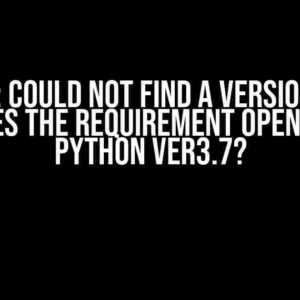Are you puzzled by the seemingly contradictory behavior of Python object instance attributes and class attributes? You’re not alone! This article dives deep into the heart of Python’s object-oriented programming, debunking myths and shedding light on the underlying mechanics. Buckle up, because we’re about to embark on a fascinating journey to understand why Python object instance attributes can differ from class attributes, even when it seems like they should be the same.
The Basics: Class and Instance Attributes
Before we dive into the mysteries, let’s establish a solid foundation. In Python, a class is a blueprint for creating objects, and each object is an instance of that class. Classes have attributes, which are essentially variables defined within the class scope. These attributes can be shared by all instances of the class, or they can be specific to individual instances.
class MyClass:
class_attribute = "I'm a class attribute!"
obj1 = MyClass()
obj2 = MyClass()
print(MyClass.class_attribute) # Output: I'm a class attribute!
print(obj1.class_attribute) # Output: I'm a class attribute!
print(obj2.class_attribute) # Output: I'm a class attribute!
In the above example, `class_attribute` is a class attribute, shared by all instances of `MyClass`. Now, let’s create an instance attribute:
obj1.instance_attribute = "I'm an instance attribute!" print(obj1.instance_attribute) # Output: I'm an instance attribute! print(obj2.instance_attribute) # Output: AttributeError: 'MyClass' object has no attribute 'instance_attribute'
As expected, `obj1` has an `instance_attribute`, but `obj2` does not. This is because instance attributes are specific to individual objects, whereas class attributes are shared by all instances.
The Mystery: Object Instance Attribute Not Same as Class
Now, let’s create a scenario that might seem counterintuitive:
class MyClass:
class_attribute = "I'm a class attribute!"
obj1 = MyClass()
obj2 = MyClass()
obj1.class_attribute = "I'm overriding the class attribute!"
print(MyClass.class_attribute) # Output: I'm a class attribute!
print(obj1.class_attribute) # Output: I'm overriding the class attribute!
print(obj2.class_attribute) # Output: I'm a class attribute!
Wait, what’s going on? We overrode the class attribute `class_attribute` on `obj1`, but `MyClass.class_attribute` still retains its original value, and `obj2` also has the original value! This seems to defy our understanding of class and instance attributes.
The Explanation: Attribute Lookup and Shadowing
The key to understanding this behavior lies in Python’s attribute lookup mechanism. When you access an attribute on an object, Python follows a specific order to resolve the attribute:
- Instance attributes: Python checks if the object has an attribute with the given name.
- Class attributes: If not found, Python looks for the attribute in the object’s class.
- Parent classes: If not found in the class, Python searches the parent classes (if any).
- Object’s `__dict__`: As a last resort, Python checks the object’s `__dict__` (a dictionary containing all instance attributes).
In our example, when we overrode `class_attribute` on `obj1`, we created a new instance attribute with the same name. This shadows the class attribute, making it seem like the class attribute has changed. However, the original class attribute remains unchanged, and other instances (like `obj2`) still access the original class attribute.
print(obj1.__dict__) # Output: {'class_attribute': "I'm overriding the class attribute!"}
print(MyClass.__dict__) # Output: {'class_attribute': "I'm a class attribute!"}
The `__dict__` attribute reveals the truth: `obj1` has an instance attribute `class_attribute`, while `MyClass` still has the original class attribute.
But Still… Why Does it Work This Way?
Now that we understand the mechanics, let’s address the elephant in the room: why does Python behave this way? There are several reasons:
- Flexibility**: By allowing instance attributes to shadow class attributes, Python provides flexibility in implementing dynamic behavior.
- Performance**: Python’s attribute lookup mechanism is optimized for performance. By checking instance attributes first, Python reduces the number of lookup operations.
- Encapsulation**: Python’s object-oriented design emphasizes encapsulation, where objects have their own state and behavior. This allows for more modular and reusable code.
Best Practices: Working with Class and Instance Attributes
Now that we’ve uncovered the mysteries of Python’s object instance attributes and class attributes, let’s discuss some best practices to keep in mind:
- Use distinct names**: Avoid using the same name for class and instance attributes to avoid confusion and unexpected behavior.
- Document your code**: Clearly document your code to indicate when class attributes are being overridden or shadowed by instance attributes.
- Use `__init__` wisely**: In your `__init__` method, avoid assigning values to instance attributes that have the same name as class attributes, unless you intend to override them.
Conclusion: Unraveling the Mystery
In conclusion, Python’s object instance attributes and class attributes may seem counterintuitive at first, but understanding the underlying mechanics reveals a beautiful, flexible, and performance-oriented design. By grasping these concepts and following best practices, you’ll become a more confident and proficient Python developer, ready to tackle even the most complex projects.
| Attribute Type | Description |
|---|---|
| Class Attribute | Shared by all instances of a class |
| Instance Attribute | Specific to individual objects, can shadow class attributes |
Remember, in Python, the line between class and instance attributes can blur, but with a deep understanding of the language, you’ll be able to wield this power to create amazing applications.
Frequently Asked Question
Get the scoop on Python object instances and attributes, and why they don’t always align with their class counterparts!
Why do Python object instances have different attributes than their class?
This happens because Python creates a separate namespace for each object instance, which can have attributes that differ from the class attributes. Think of it like a blueprint (class) vs. the actual house (object instance) – they might not have the same furniture or decorations!
But wait, I thought Python objects inherited attributes from their class?
You’re absolutely right! Python objects do inherit attributes from their class. However, when you assign a new value to an attribute in an object instance, it creates a new attribute in the instance’s namespace, overriding the one inherited from the class. It’s like the object instance is saying, “Hey, I want my own version of that attribute, not the one from my class!”
How can I check if an attribute belongs to an object instance or its class?
You can use the `hasattr()` function to check if an attribute exists in an object instance or its class. If the attribute is found in the instance, `hasattr()` will return `True`. If not, it will check the class and its parent classes. Alternatively, you can use the `dir()` function to list all attributes and methods of an object instance or its class.
Can I change an attribute of a class and have it affect all its object instances?
Yes, if you modify a class attribute after creating object instances, the change will be reflected in all instances that don’t have their own version of that attribute. However, if an object instance has already overridden the attribute, changing the class attribute won’t affect it. It’s like trying to change the blueprint after the house is built – it won’t affect the existing houses, but it will affect new ones built from the updated blueprint!
Are there any best practices for managing attributes in Python object instances and classes?
Yes, it’s essential to follow best practices to avoid attribute-related issues. Use descriptive and consistent naming conventions, avoid overriding attributes with the same name as a method or function, and use documentation strings to explain the purpose and behavior of attributes and methods. By following these guidelines, you’ll keep your code organized, readable, and maintainable!




